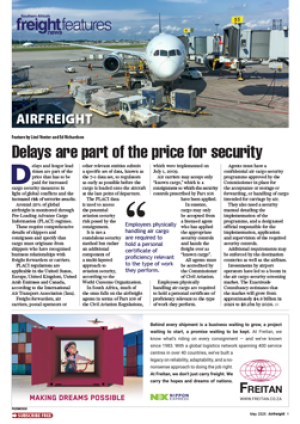Angola and DRC look promising
Joy Orlek
SHIPPING LINES are facing unprecedented challenges.
Charter rates have rocketed by up to 200%
in the last six months resultingg in a capacity shortage worldwide. Linked to this, shipyards are fully committed until 2007 which can only
mean ongoing capacity pressure for lines and their customers.
“It’s a supply and demand situation, so shippers should factor in increases for the next two to three years because the situation is unlikely to change until more capacity comes on stream,” says Safmarine’s Cape Town-based Africa region executive, Alan Jones.
In Africa, the unique infrastructural problems place additional stress on seafreight carriers.
“With the cost of ships going up, the cost of calling at all ports is no longer feasible, and the hub concept therefore makes the most logical sense.
“And this is where South Africa could have a major role to play. We are ideally situated, being half way between east and west, and we have the ability to do it,” says Jones, who has spent the past three years in Singapore, which is arguably a text book success story.
“If we succeed in developing South Africa as the transhipment hub for sub Saharan Africa, the sky’s the limit. It will however require a significant improvement in port productivity and efficiency to achieve this.”
Trade into Africa is however growing in strides, says Jones.
“Clearly there’s more and more South African influence in terms of shops and products. We’ve seen it in Uganda, Kenya, Tanzania and even into West Africa, all of which highlights the potential for further growth.”
And the logical assumption is that the oil ports of West Africa will be the focal areas of the future because of the current dependency on the Middle East and the uncertainty of oil supplies. Investment by American companies will clearly ensure that oil ports grow more quickly than the rest.
But Jones is also bullish about prospects in Angola and the DRC whose economies are in revival mode following their recovery from civil unrest .
“From a Safmarine point of view these ports are all well served, but because of congestion problems in West Africa we are constantly reassessing our traditional service patterns.”
Few would argue that the biggest challenge, particularly in West Africa, is on the operational side. “It’s the port efficiency, intermodal logistics links and general infrastructure that are often not up to standard and which often cause delays which the shipping line is forced to absorb.”
Safmarine is one of the few carriers to offer a breakbulk service into West Africa. “Because it is relatively under-developed we see substantial growth potential for non-containerisable cargo.”
In view of these operational difficulties, regional expertise is paramount, says Jones.
The line is represented in 40 countries on the continent, 35 of which are own offices. “And that’s directly related to improving the service. Where business is sufficient our intention is to have our own representation.”
